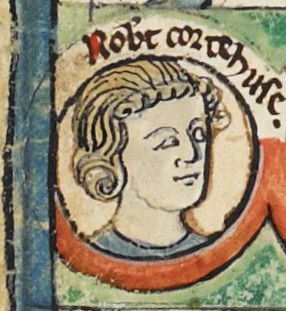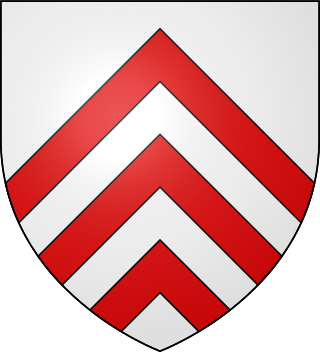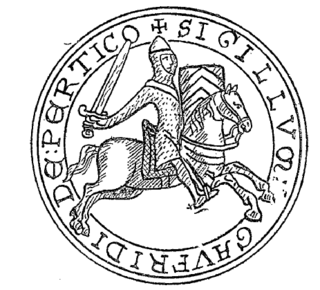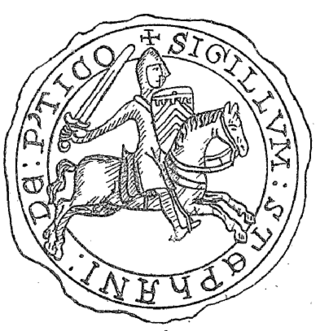
Richard I, known as Richard Cœur de Lion or Richard the Lionheart because of his reputation as a great military leader and warrior, was King of England from 1189 until his death in 1199. He also ruled as Duke of Normandy, Aquitaine, and Gascony; Lord of Cyprus; Count of Poitiers, Anjou, Maine, and Nantes; and was overlord of Brittany at various times during the same period. He was the third of five sons of Henry II of England and Eleanor of Aquitaine and was therefore not expected to become king, but his two elder brothers predeceased their father.

Year 1189 (MCLXXXIX) was a common year starting on Sunday of the Julian calendar. In English law, 1189 - specifically the beginning of the reign of Richard I - is considered the end of time immemorial.

Robert II of Normandy, or Robert Curthose, was the eldest son of William the Conqueror and succeeded his father as Duke of Normandy in 1087, reigning until 1106. Robert was also an unsuccessful claimant to the throne of the Kingdom of England. The epithet "Curthose" had its origins in the Norman French word courtheuse 'short stockings' and was apparently derived from a nickname given to Robert by his father; the chroniclers William of Malmesbury and Orderic Vitalis reported that William the Conqueror had derisively called Robert brevis-ocrea.

Henry the Lion, also known as Henry III, Duke of Saxony and Henry XII, Duke of Bavaria, was a member of the Welf dynasty.

Geoffrey V, called the Handsome, the Fair or Plantagenet, was the Count of Anjou, Touraine and Maine by inheritance from 1129, and also Duke of Normandy by his marriage claim, and conquest, from 1144.

Geoffrey II was Duke of Brittany and 3rd Earl of Richmond between 1181 and 1186, through his marriage to Constance, Duchess of Brittany. Geoffrey was the fourth of five sons of Henry II of England and Eleanor, Duchess of Aquitaine.
Geoffrey was an illegitimate son of King Henry II of England who became bishop-elect of Lincoln and archbishop of York. The identity of his mother is uncertain, but she may have been named Ykenai. Geoffrey held several minor clerical offices before becoming Bishop of Lincoln in 1173, though he was not ordained as a priest until 1189. In 1173–1174, he led a campaign in northern England to help put down a rebellion by his legitimate half-brothers; this campaign led to the capture of William, King of Scots. By 1182, Pope Lucius III had ordered that Geoffrey either resign Lincoln or be consecrated as bishop; he chose to resign and became chancellor instead. He was the only one of Henry II's sons present at the king's death.

The House of Plantagenet was a royal house which originated in the French County of Anjou. The name Plantagenet is used by modern historians to identify four distinct royal houses: the Angevins, who were also Counts of Anjou; the main line of the Plantagenets following the loss of Anjou; and the houses of Lancaster and York, two of the Plantagenets cadet branches. The family held the English throne from 1154, with the accession of Henry II, until 1485, when Richard III died.

Ranulf de Blondeville, 6th Earl of Chester and 1st Earl of Lincoln, known in some references as the 4th Earl of Chester, was one of the "old school" of Anglo-Norman barons whose loyalty to the Angevin dynasty was consistent but contingent on the receipt of lucrative favours. He has been described as "almost the last relic of the great feudal aristocracy of the Conquest".
Robert de Mowbray, a Norman, was Earl of Northumbria from 1086 until 1095. Robert joined the 1088 rebellion against King William II on behalf of Robert Curthose, but was pardoned and later led the army that killed Malcolm III of Scotland at Alnwick. In 1095, he conspired to put Stephen of Aumale on the throne, was besieged by the king, and captured. As punishment, his marriage was dissolved and his lands confiscated, given to the new husband of his former wife, while Mowbray was imprisoned for life and later became a monk.

The county of Perche was a medieval county lying between Normandy and Maine.

Enguerrand III de Boves, Lord of Coucy was a medieval French nobleman. The eldest son and successor of Ralph I, Lord of Coucy and Alix de Dreux, he succeeded as Lord of Coucy in 1191, and held it until his death; he was also lord of Marle and Boves.
Events from the 1180s in England.

Matilda of England was an English princess of the House of Plantagenet and by marriage Duchess consort of Saxony and Bavaria from 1168 until her husband's deposition in 1180.
Matilda of Saxony may refer to:
Rotrou IV (1135-1191), was the Count of Perche. He joined Louis VII of France in a war against Henry II of England, in which he lost lands to the English. Rotrou later went on crusade with Philip II of France and died after the Siege of Acre in 1191.

Geoffrey III was the count of Perche from 1191 until his death.
Thomas, Count of Perche, was the son of Geoffrey III, Count of Perche, and Matilda of Saxony, daughter of Henry the Lion, Duke of Saxony and Bavaria, and Matilda of England. He died young.

Sandleford Priory was a small Augustinian Priory, the remains of which now stand at Sandleford in the civil parish of Greenham in the English county of Berkshire.

Stephen du Perche was a French nobleman and crusader. He was a partisan of the Plantagenets in their conflict with the French crown and held fiefs from them. A younger son, he governed the County of Perche on behalf of his father and brother during their absence on crusade. He himself joined the Fourth Crusade in 1202 and travelled to the Holy Land. Afterwards, he went to the Latin Empire and was appointed duke of Philadelphia in Asia Minor in 1204. He died in battle against the Bulgars.













